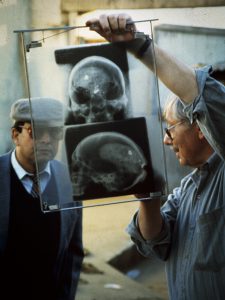When we think of archaeologists, we tend to think of people digging thousand-year-old mummies from the ground. This isn’t always the case. Forensic anthropologists use physical anthropology and bio archaeology to help solve legal cases. This field has become extremely essential in recent years due to the high numbers of genocide and the unidentified victims. Dr. Eric Stover, director of the Human Rights Center at UC Berkley, has traveled to Rwanda, Guatemala, Iraq and other sites of genocide in order to bring closure to the families and punish those who committed these atrocious war crimes. Forensic anthropologists examine not only the cause of death and identify of the victim, but also look towards the greater cultural impact of their death. Dr. Stover learned that “…the means of killing is often easy to identify, whether by machete or rifle. And evidence of execution is often readily apparent as well…”. For him, it is more difficult to identify the victims, determining their approximate age and sex through bone and dental records when the country is in the midst of turmoil. His victims, however, tend to be recent and still have evidence of ID, keys, money and other factors in the event that they could return home.
The Dirty War in Argentina was waged from 1976-1983 by Argentina’s military dictatorship in an attempt to get rid of left-wing opposition. Thousands of Argentinian citizens were executed or simply “disappeared”. Dr. Stover traveled to Argentina in 1984 after three women showed up at his office begging him to find their loved ones. The women told Dr. Stover that pregnant women were kidnapped and executed after giving birth to supply military couples with children. This piece of cultural evidence allows Dr. Stover to contextualize the murders and place stories, background and a path for prosecution behind the victim’s identification. Liliana Pereyra, a 21-year-old pregnant student, disappeared in October 1977. After the military junta was overthrown, government officials told Perevyra’s mother that she died in a shoot out with the police in an attempt to cover up her murder. In 1985 Stover and a team of archaeologists and anthropologists exhumed a grave containing three bodies. Dr. Stover used x-rays taken of Liliana to match her with one of the bodies and to identify the method of execution. When he gathers this information, he gains pieces of evidence to persecute the perpetrators.

Dr. Clyde Snow, a forensic anthropologist who helped successfully identify aspects of the assassination of JFK, inspects x-rays of a skull fractured by a bullet.
Forensic anthropology is a controversial field when the identifications of genocide victims are at stake. The exhumation of bodies and of objects is always a tricky situation in regards to archaeology because you risk damaging the area, disturbing something that was not meant to be disturbed and destroying artifacts and bodies. A specialist is needed who has a multi disciplinary background in order to not only scientifically identify the victims but place them in a larger social context for greater analysis, a perfect skill for anthropologists. In the case of genocide victims, forensic anthropology is necessary because the victims did not die of their own accord, but a violent political death that deserves remembrance.
Sources:
Nuwer, Rachel. “Reading Bones to Identify Genocide Victims.” The New York Times, The New York Times, 18 Nov. 2011, atwar.blogs.nytimes.com/2011/11/18/reading-bones-to-identify-genocide-victims
“Dirty War.” Encyclopædia Britannica, Encyclopædia Britannica, inc., 20 Mar. 2014, www.britannica.com/event/Dirty-War
Renfrew, Colin, and Paul Bahn. Archaeology Essentials: Theories, Methods, Practice. 3rd ed., Thames & Hudson, 2015.
Image Sources:
Nuwer, Rachel. “Reading Bones to Identify Genocide Victims.” The New York Times, The New York Times, 18 Nov. 2011, atwar.blogs.nytimes.com/2011/11/18/reading-bones-to-identify-genocide-victims
“Dead Reckoning: War, Crime, and Justice from WW2 to the War on Terror | Press Release | Pressroom | THIRTEEN.” Pressroom, www.thirteen.org/13pressroom/press-release/dead-reckoning-war-crime-justice-ww2-war-terror/
Further Reading:
https://fsu.digital.flvc.org/islandora/object/fsu:183025/datastream/PDF/view
https://www.amazon.com/Bone-Woman-Forensic-Anthropologists-Croatia/dp/0812968859
http://www.cnn.com/2008/WORLD/europe/11/25/sbm.bosnia.bone.detectives/


What are some key ways forensic anthropologist go about determining age and sex of a skeleton? If a victim was shot and it did no damage to the skeleton can a forensic anthropologist/bioarchaeologist determine how that individual died?